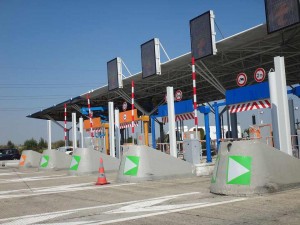The Eurovignette, the name for the unified fare system that the EU is promoting for the road network in Member States, continues giving news. The latest is the European Parliament’s approval of a draft regulation that proposes going from a fare based on time of use to a toll based on the distance travelled.
What is the Eurovignette and where is it from?
The Eurovignette is the nickname given to the fare that heavy vehicles over 3.5 tonnes must currently pay to travel on the road network in European countries such as Holland, Luxembourg, Sweden and Denmark.
The aim of this fare is to offset external costs stemming from use of the roadway infrastructures. This means expenses related to wear on roads, traffic on the network, accidents and also expenses related to the environment and health, such as pollution, noise, etc.
The vignette concept was first used in France in the 1950s, as way to have vehicle users bear the costs for roads. Its name comes from the sticker the driver purchases and puts on the windscreen. What sets it apart from other tolls is that it acts a flat rate throughout the entire purchase period.
At the end of the 90s and early 2000s, there were movements in the UE TO create a European vignette, thus homogenising payment methods throughout the union’s roads. However, since this directive was voluntary, meaning only applied by countries that decide to do so, mainly only central European countries joined, while outlying countries were more removed from the system.
From time to distance
If the new proposal is approved, now in hands of the European Commission after gaining the Parliament’s approval, beginning 2023, it will affect over 136,000 kilometres of roads and motorways in the Trans-European Transport Network, where tolls of this sort already exist. The Eurovignette will still not be binding for Member States, so each government can decide whether to apply it to the roads in its their countries.
One of the main new developments affecting transporters is that the current fare system will change, which is based on the time of use of the road network. The new standard proposes counting the kilometres travelled by vehicles weighing more than 3.5 tonnes. This means that, beginning 2023, time-based tolls will be replaced by new tolls based on distance.
Changes in vehicle types
Another one of the key factors in the new regulation is changing the kind of vehicle to which the Eurovignette is applicable, broadening the tax that affected lorries. Now it will also be levied on vans, buses and even private cars. MEPs thus defend the rate being applied to all transport vehicles, whether freight or passenger, claiming that this guarantees fair treatment for transporters.
This final announcement of exemptions currently applicable to lightweight vehicles means meeting with a demand of transport companies. Therefore, this proposal was warmly welcomed by the European Road Haulers Association (UETR), since its opinion is that this change guarantees the impartiality and efficiency of the Eurovignette.
In the midst of the battle to halt climate change, the new Eurovignette highlights the environmental aspect. In this regard, countries must establish different rates for vehicles based on the degree of CO2 emissions, thus fomenting the use of vehicles that pollute less. This reworking of the Eurovignette validates the UETR, which rejected surcharges for pollution related to traffic falling solely on transport companies.


